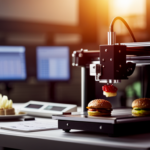In a world where culinary innovation is no longer confined to the realm of traditional cooking, the emergence of food 3D printing has sparked a new wave of competition and creativity.
This article delves into the competitive landscape of food 3D printing, examining key players, industry trends, and the challenges and opportunities facing consumer adoption.
As this technology continues to evolve, its impact on the future of food production and consumption cannot be understated.
Market Overview
The market overview for food 3D printing reveals a dynamic landscape with growing interest and investment from various sectors. Market analysis indicates that the global food 3D printing market is anticipated to witness significant growth in the coming years. This surge is attributed to the increasing demand for customized food products, technological advancements in 3D printing, and the rising need for convenience in food preparation.
The technology advancements in 3D printing have led to the development of printers capable of producing a wide range of food items, including confectionery, snacks, and even complex multi-textured dishes. Additionally, the integration of innovative materials such as edible pastes, gels, and powders has expanded the possibilities for creating nutritious and appealing 3D printed food products.
Moreover, the potential for reducing food waste through on-demand production and the personalization of nutritional content further contribute to the market’s attractiveness. As a result, industry players, including food manufacturers, technology firms, and research institutions, are increasingly investing in and exploring the potential of food 3D printing, indicating a promising and competitive market landscape.
Key Players and Innovations
Amid the burgeoning interest and investment in food 3D printing, industry leaders are spearheading innovative developments and collaborations to propel the technology forward.
Key players in the food 3D printing sector include companies such as Natural Machines, 3D Systems, and BeeHex, each contributing unique advancements to the field. These players are actively engaging in partnerships with food manufacturers, culinary experts, and technology companies to expand the capabilities of food 3D printing. These partnerships aim to streamline the integration of 3D printing into food production processes and enhance the variety of printable materials, such as edible pastes, chocolates, and plant-based ingredients.
In addition to partnerships, significant innovations are being made in materials and design improvements. Companies are investing in research to develop food-safe printing materials that meet regulatory standards and enhance the taste, texture, and nutritional value of the printed food. Furthermore, there is a focus on refining the design capabilities of 3D food printers to enable intricate and customizable food creations.
These innovations are driving the evolution of food 3D printing and positioning the industry for substantial growth and widespread adoption.
Industry Trends and Growth
Key players in the food 3D printing sector are driving industry trends and growth through strategic collaborations and technological advancements. Technology advancements have significantly enhanced the capabilities of food 3D printing, allowing for more intricate and customizable food designs. This has led to an increased market demand for 3D printed food products, as consumers are drawn to the novelty and personalization offered by this technology.
Moreover, industry leaders are focusing on revenue growth and global expansion by capitalizing on the rising interest in 3D printed food across different regions. As a result, the food 3D printing market is experiencing substantial revenue growth, with companies exploring new markets and expanding their product offerings. Additionally, the industry is witnessing an influx of investments aimed at further advancing the technology and scaling production capabilities to meet the growing demand.
These industry trends and growth initiatives are shaping the landscape of food 3D printing, paving the way for widespread adoption and integration of this innovative technology into the food industry.
This sets the stage for understanding the consumer adoption and challenges in the next section.
Consumer Adoption and Challenges
Driven by increasing market demand and technological advancements, the consumer adoption of food 3D printing is gaining momentum, accompanied by challenges that necessitate careful consideration.
The benefits of food 3D printing, such as customization, waste reduction, and enhanced nutritional value, are driving its adoption among consumers. Customization allows for personalized dietary needs and preferences, while the technology advancements in 3D printing enable the creation of intricate food designs and textures that are otherwise challenging to achieve through traditional methods.
However, challenges related to consumer acceptance, affordability, and food safety regulations need to be addressed for widespread adoption.
Consumer acceptance remains a significant hurdle, as the concept of consuming 3D-printed food is still relatively new and may face resistance from traditionalists. Additionally, the affordability of 3D food printers and the associated costs of ingredients and maintenance could impede adoption among cost-conscious consumers.
Moreover, ensuring food safety and compliance with regulatory standards is crucial for building consumer trust.
Addressing these challenges will be pivotal in fostering consumer confidence and driving the widespread adoption of food 3D printing.
Future Prospects and Opportunities
In the foreseeable future, the expanding applications and technological advancements in food 3D printing are poised to create new opportunities for innovation and market growth. This burgeoning industry holds immense potential, offering a glimpse into a future where personalized nutrition, sustainable food production, and culinary creativity converge.
The following prospects and opportunities are expected to shape the landscape of food 3D printing:
-
Customized Nutrition: Innovative applications in food 3D printing will enable the creation of personalized dietary options tailored to individual nutritional needs and preferences. This could revolutionize the way people consume food, addressing health concerns and dietary restrictions with bespoke solutions.
-
Sustainable Food Production: Technological advancements in 3D printing may facilitate the production of food from alternative, sustainable sources such as algae, fungi, or insect-based ingredients. This has the potential to mitigate environmental impact and contribute to more eco-friendly food production practices.
-
Culinary Exploration: Food 3D printing opens doors to unprecedented culinary creativity, allowing chefs and food innovators to experiment with intricate designs, textures, and flavors. This presents an opportunity for the creation of novel dining experiences and gastronomic delights that were previously unimaginable.
These developments are expected to drive the evolution of food 3D printing, offering promising prospects for businesses and consumers alike.
Frequently Asked Questions
What Are the Current Limitations of Food 3D Printing Technology in Terms of Ingredient Compatibility and Taste?
The current limitations of food 3D printing technology, in terms of ingredient compatibility and taste perception, are centered around the need for advancements in material science to ensure a wider range of edible materials and enhanced flavor profiles.
How Are Regulatory Bodies Addressing the Safety and Hygiene Concerns Related to Food 3D Printing?
Regulatory bodies are diligently addressing safety and hygiene concerns associated with food 3D printing. Implementing stringent measures for compliance, they focus on upholding hygiene standards, ensuring consumer protection, and safeguarding against potential risks.
Are There Any Notable Partnerships or Collaborations Between Food 3D Printing Companies and Traditional Food Manufacturers?
Partnership opportunities in food 3D printing are emerging as traditional food manufacturers seek to integrate this technology into their processes. Market trends indicate a growing interest in collaborations to leverage expertise and innovative capabilities.
What Are the Potential Environmental Impacts of Widespread Adoption of Food 3D Printing Technology?
The potential concerns regarding widespread adoption of food 3D printing technology encompass its impact on environmental sustainability, resources, and waste management. Balancing innovation with responsible consumption is crucial for mitigating adverse environmental impacts.
How Are Cultural and Regional Food Preferences Being Considered in the Development of Food 3D Printing Products and Services?
Cultural adaptation and regional customization are pivotal considerations in the development of food 3D printing products and services. These factors ensure that the technology aligns with diverse culinary preferences, fostering acceptance and integration within various communities.
Conclusion
In conclusion, the competitive landscape of food 3D printing is dynamic and evolving. Key players continue to innovate, driving industry growth and shaping consumer adoption.
Despite challenges, the future prospects and opportunities for food 3D printing are promising. As the industry continues to expand, it presents a landscape of innovation, growth, and potential for the future.


